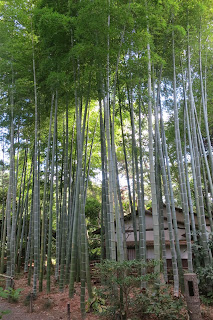In honor of October, we went to Oktoberfest in Yokohama a few weekends ago with a bunch of friends in an annual tradition which I am sure we will keep over the next few years. The fest is put on by the German embassy in Japan, complete with live German music and lots of German beer and food. Judging by friends pictures from the actual Oktoberfest in Munich, I don't think it was quite as crazy, but still a good time. And I don't think they eat sausage with chopsticks and serve edamame as a side dish in Germany. :) The festival is held in Yokohama Redbrick Warehouse, fitting because Yokohama is the birthplace of Japanese beer. The warehouse is right on the water, and was originally used as custom buildings. Now, it is used a shopping mall and banquet/event center.
Lots of great beers - German and local beers, and you could keep the glass they served it in if you wanted. Kenny collected quite a few for his collection. Below are some pictures from the festivities.
The Sankeien Garden is a traditional Japanese-style garden created by Sankei Hara, who made his fortune through silk trading business in Yokohama. He designed the gardens himself and had historically significant buildings from all over Japan placed throughout the grounds. Construction on the garden started in 1902 and took 20 years to complete.
 |
| Main Pond at the entrance |
 |
| Another view of main pond |
The garden is divided into the Inner and Outer Gardens. The outer garden was open to the public even when Sankei lived on the grounds, and has abundant flowers. The inner garden is where the Hara family lived and is more subdued in order to enjoy the historic buildings.
Below are pictures of the Rinshunkaku. These buildings were originally built in 1649 and moved to the garden in 1917.
Below are some more pictures of the inner garden:
The 3 story pagoda of Old Tomyoji was built in 1457 and moved to the garden in 1917. This is currently the oldest wooden pagoda in the Kanto region (an area in Honshu - the largest island in Japan - consisting of 7 prefectures/states).
The next picture is the view from the hill the pagoda is located on. I like this one because it shows the juxtaposition between old historic Japan and the present day Japan.
More pictures of the outer garden - I imagine even more beautiful when flowers are in bloom.
 |
| A couple getting their wedding pictures taken. |
After the garden, we went to Yokohama's Chinatown again, this time to eat. We had a delicious Chinese dinner of duck, dim sum and fried rice. Delicious.
While there, we noticed quite a few places serving shark fin soup. This is considered a delicacy in Chinese cuisine, and considered one of eight treasured foods from the sea. In the Chinese culture, it is also suggested that shark fin contains properties to boost sexual potency, enhance skin quality, increase energy, prevent heart disease and lower cholesterol. This delicacy is also very controversial, as shark finning leaves the shark to die in the water and has been cited to be the cause of the declining shark population worldwide. There are many states in the U.S. that ban the sale/use of shark fins, and quite a few restaurants here in Japan also will not serve it due to sustainability concerns. The soup is quite expensive - in the picture below, the soup on the far left cost about $15, and the soup on the far right costs about $130, with every size between.
Last, but certainly not least - our stuff was delivered! As we thought, much of the bedroom furniture had to be lifted over the balcony as it would not fit up the narrow steps. We had to unpack all the boxes immediately when delivered, so we would not have to deal with the trash/cardboard waste here due to the recycling craziness. So, it made for quite a mess. I'm used to unpacking one box at a time and having the rest of the boxes stacked all neatly until you can get to them. The advantage to the way we had to do it, is that things were put away quite quickly. :) Before are moving pictures and some before/after of our place. Still some work to do, but coming together nicely.
 |
| Guest bedroom - all ready for visitors :) |
 |
| It looks like neither of us needs more clothes, haha :) |
This holiday weekend, we are going to Hiroshima and Miroyama Island, including our first ride on the bullet train!














































No comments:
Post a Comment